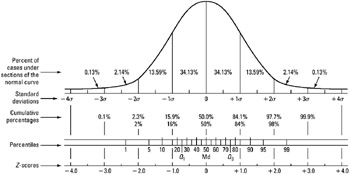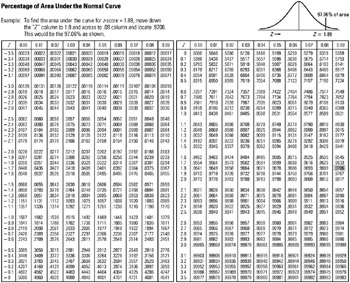Tool 119: Normal Probability Distribution
| AKA | Gaussian Curve |
| Classification | Analyzing/Trending (AT) |
Tool description
The normal probability distribution is used extensively in statistical process control (SPC) applications, the profiling and describing of various data distributions, and in the hypothesis testing procedures (inferential statistics) found in scientific research. The concepts of normally distributed sample data provide the basis for inferences made about a population based on samples taken from the source population.
Typical application
-
To illustrate variability of data.
-
To apply the "normal" pattern concepts to statistical process control activities.
-
To demonstrate data significance, allow transformations, and display measurement scales and their relationship under the curve.
Problem-solving phase
| Select and define problem or opportunity | |
| → | Identify and analyze causes or potential change |
| Develop and plan possible solutions or change | |
| Implement and evaluate solution or change | |
| → | Measure and report solution or change results |
| Recognize and reward team efforts |
Typically used by
| 1 | Research/statistics |
| Creativity/innovation | |
| 2 | Engineering |
| Project management | |
| Manufacturing | |
| Marketing/sales | |
| Administration/documentation | |
| Servicing/support | |
| 3 | Customer/quality metrics |
| Change management |
before
-
Data Collection Strategy
-
Surveying
-
Frequency Distribution (FD)
-
Standard Deviation
-
Cluster Analysis
after
-
Descriptive Statistics
-
Process Capability Ratios
-
Analysis of Variance
-
Control Chart
-
Response Matrix Analysis
Notes and key points
-
The normal probability distribution is a symmetrical, bell-shaped distribution frequently used in statistical analyses. The arithmetic mean,
 median
median  and mode
and mode  are of equal value and are located at the center and peak of the curve. These measures are averages and therefore considered measures of central tendency. Measures of dispersion are measures under the curve, moving horizontally left or right to identify areas or probability, among others, standard deviations (S), z-values (z), and percentiles (%) are most often used in descriptive and inferential statistics.
are of equal value and are located at the center and peak of the curve. These measures are averages and therefore considered measures of central tendency. Measures of dispersion are measures under the curve, moving horizontally left or right to identify areas or probability, among others, standard deviations (S), z-values (z), and percentiles (%) are most often used in descriptive and inferential statistics.
-
Please refer to Appendix, Table A, "Proportions of Area Under the Normal Curve," for a detailed table.

Step-by-step procedure
-
STEP 1 Collect a sample of data for the purpose of checking quality goals, process capability, or probability of defects (excessive variability). See example Normalizing Sample Data for SPC Applications.
-
STEP 2 Calculate the population mean (μ) and standard deviation (σ).
-
STEP 3 Transform any measurement, using the z-score equation as shown in this example.
-
STEP 4 Refer to the Proportions of Area Under the Normal Curve table to locate the percentage of probability of area under the curve (See Appendix, Table A.)
Example of tool application

EAN: 2147483647
Pages: 326